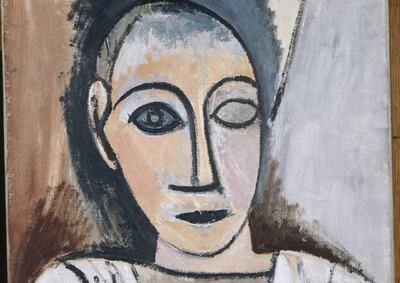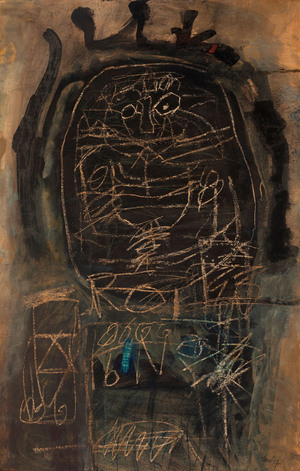Medieval art under the gaze of the Vanguards
From the last years of the 19th century, the foundations and formulations under which figuration had been founded began to falter. until generating a change of orientation that left behind its traditional descriptive function to be conceived as a way to unravel the essence of the universe and explain the deepest part of the human being. In this context of rupture, Western painting questioned naturalism whose codes of representation had ceased to identify with the new reality they wanted to express. In this way, the artist faced with the task of redefining the very nature of art decided to act as a “new primitive” completely apart from any aesthetic convention.
The definitive break came with the historical avant-gardes and their firm belief in the need to return to the origins as the only means of rediscovering the lost purity . In this evocation of the lost arcade, it was essential to also recover those forms of expression connected to the most authentic essence of the human being, the one from which progress, industrialization and urbanization were moving them away. In this way, the need felt by a good part of the avant-garde artists to return to a primitive state, to the shared desire to articulate a virgin language, uncontaminated and completely outside of tradition, led them to reconnect with those forms of most primitive expression. This search for alternatives to figuration itself led them at first to those manifestations from the East of a markedly exotic nature, to later turn their gaze towards those more archaic forms of expression typical of Western art, which, like primitive art or medieval art, moved away from the figurative tradition of Renaissance origin.
In this recovery of medieval art, the development of avant-garde movements contributed substantially, such as Fauvism, Cubism and Expressionism, valued the anti-naturalistic character of their representations, whose tendency to conceptualization and schematization was integrated into the avant-garde plastic language as a formal reference, without assuming the religious and social ideals of a Catholic nature. In this sense, it is not by chance that the interest in those periods outside the classicist tradition coincides with the start of the artistic theory of pure visibility, which, taking into account the intrinsic meaning of forms over and above their narrative or descriptive content, saw in Romanesque art is the freest and least conventional artistic expression of the West. Therefore, this assimilation by European avant-garde artists of the representative codifications of primitive and medieval peoples responds to a need to find new expressive formulas in line with their particular search for a new concept of spirituality where art will recover the value of the sacred.
In this sense, many Spanish artists, such as Miró, Picasso, Antoni Clave or Antoni Tàpies, took medieval iconography and specifically Romanesque as a source of inspiration for their creations. We only have to think of the characteristic figures of Picasso whose archaic reminiscences are reflected in such distinctive Romanesque features as the stylization of the bodies, the typically almond-shaped eyes or the frontality and hieratic nature of his compositions. In fact, Picasso’s fascination with medieval Catalan art and Romanesque art in general did not occur merely at an archaeological level, but rather, from an artistic point of view, it was a source of inspiration whose symbolic language, elemental purity of signs and direct expressiveness, he applied and reinterpreted under his own artistic conception.

The definitive break came with the historical avant-gardes and their firm belief in the need to return to the origins as the only means of rediscovering the lost purity . In this evocation of the lost arcade, it was essential to also recover those forms of expression connected to the most authentic essence of the human being, the one from which progress, industrialization and urbanization were moving them away. In this way, the need felt by a good part of the avant-garde artists to return to a primitive state, to the shared desire to articulate a virgin language, uncontaminated and completely outside of tradition, led them to reconnect with those forms of most primitive expression. This search for alternatives to figuration itself led them at first to those manifestations from the East of a markedly exotic nature, to later turn their gaze towards those more archaic forms of expression typical of Western art, which, like primitive art or medieval art, moved away from the figurative tradition of Renaissance origin.
In the case of Clavé , the challenge he faced by accepting in the mid-1950s the highly bibliophile commission to illustrate François Rebelais’s Gargantua, laid the foundations under which later It would give birth to some of his most memorable series such as that of the Warriors or Kings . Through them, and imbued by the deep knowledge of the medieval imaginary that he acquired to illustrate this satire of the society of the time, we can follow the unstoppable evolution that his plastic language undergoes from the initial figuration until reaching the creative fullness of his works. more abstract. In this way, the first more or less realistic representations will gradually give way to an abstraction where the figure constitutes the axis or structuring scheme of a painting that, as in this case, will be dominated by the expressive force of the chromaticism, of the gestures of the strokes and the richness of its textures. However, Clavé’s link with medieval art is not limited to the merely thematic aspect, but also shines through in the way in which he conceives a composition dominated by the disproportion of the figures, whose large heads stand out as a fundamental expressive element, as well as such as frontality, hieraticism and lack of perspective between background and figure.
It is evident how during the artistic Vanguards there was a revival, review and reinterpretation of the medievalist plastic formulas to which the artists resorted to give birth to a new chapter in the history of art, which, despite signifying a total break with the conventions established so far, he did not stop looking at the artistic past.






